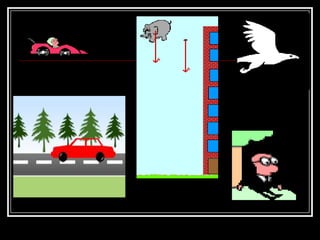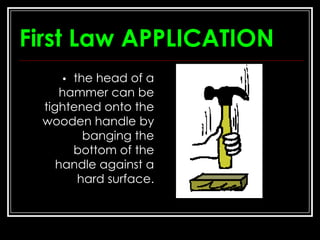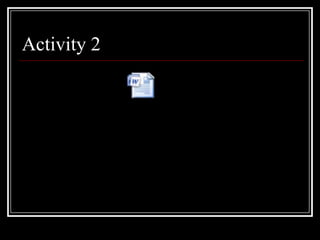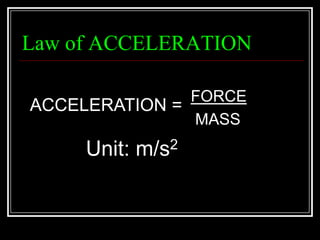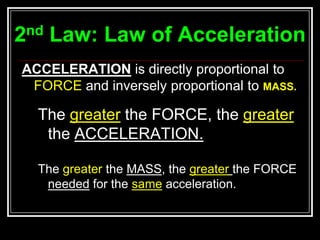Newton demo
- 2. Why do objects move the way they do?
- 3. Newton ‘s laws of motion
- 4. OBJECTIVES: 1. state Newton’s laws of motion. 2. explain how the mass of an object affects inertia. 3. discuss the relationship of net force, mass and acceleration. 4. give examples of the practical applications of Newton’s law in daily activities 5. appreciate the application of Newton’s law of motion in transport safety.
- 5. Activity 1
- 7. Newton’s First Law Law of INERTIA An object at rest tends to stay at rest and an object in motion tends to stay in motion unless acted upon by an unbalanced force.
- 8. First Law: Law of Inertia
- 9. First Law: Law of Inertia
- 10. What does this mean? Basically, an object will “keep doing what it was doing” unless acted on by an unbalanced force. If the object was sitting still, it will remain stationary. If it was moving at a constant velocity, it will keep moving. It takes force to change the motion of an object.
- 11. First Law: Law of Inertia Inertia Tendency of a body to stay at rest when it is at rest or to stay in uniform motion in a straight line unless acted upon by an external force. Qualitative in nature Dependent on mass
- 12. First Law: Law of Inertia m ~ Inertia m ~ inertia
- 13. Why was it so difficult to stop the TITANIC from colliding with the iceberg?
- 14. The mass of the Titanic is very large. Inertia is proportionate to mass. The Titanic could not change its direction because its extremely high inertia forces it to continue in a straight line, thereby colliding with the iceberg. men u
- 15. First Law: Law of Inertia
- 16. SEATBELT LAW!!! • REPUBLIC ACT NO. 8750 • an act requiring the mandatory compliance by MOTORISTS of private and public vehicles to USE SEAT BELT devices, and requiring vehicle manufacturers to install SEAT BELT devices in all their manufactured vehicles
- 17. Think! Why is it important for a passenger vehicle driver not to step on the break hardly when the vehicle is fast moving?
- 18. First Law APPLICATION • to dislodge ketchup from the bottom of a ketchup bottle, the bottle is often turned upside down, thrust downward at a high speed and then abruptly halted.
- 19. First Law APPLICATION • the head of a hammer can be tightened onto the wooden handle by banging the bottom of the handle against a hard surface.
- 20. First Law: Law of Inertia • =0 •a = 0 •Object is at rest Fnet =0 • = constant •a = 0 •Object moves at the same speed and direction
- 21. Activity 2
- 23. Newton’s Second Law Law of ACCELERATION The acceleration of an object is directly proportional to the net force acting on it and inversely proportional to its mass.
- 24. Law of ACCELERATION FORCE ACCELERATION = MASS Unit: m/s 2
- 25. 2nd Law: Law of Acceleration ACCELERATION is directly proportional to FORCE and inversely proportional to MASS. The greater the FORCE, the greater the ACCELERATION. The greater the MASS, the greater the FORCE needed for the same acceleration.
- 26. 2nd LAW: Law of Acceleration
- 27. What does F = ma say? Something very massive (high mass) that’s changing speed very slowly (low acceleration), like a glacier, can still have great force. Something very small (low mass) that’s changing speed very quickly (high acceleration), like a bullet, can still have a great force. Something very small changing speed very slowly will have a very weak force.
- 28. Activity 3
- 30. Newton’s Third Law Law of ACTION-REACTION For every action there is an equal and opposite reaction.
- 31. Think! Why do the forces not cancel each other?
- 32. 3 rd Law Because the pair of force acts on different objects that is why forces do not cancel.
- 34. 3rd Law The reaction of a rocket is an application of the third law of motion. The hot gases push against the inside tube of the rocket and escape out the bottom of the tube. As the gases move downward, the rocket moves in the opposite direction.
- 35. 3rd Law of Motion Flying gracefully Reaction through the air, birds depend on Newton’s third law of motion. As the birds push down on the air with their wings, the air pushes their wings up and gives Force them lift.
- 36. Summary: Newton’s Laws of motion a. Law of inertia b. Law of acceleration c. Law of action-reaction
- 37. AGREEMENT 1. Give situations that demonstrate Newton’s Laws of Motion. 2. Research on the application of Newton’s laws of motion in transport safety.
- 38. References: Internet http://www.physicsclassroom.com/mmedia/ne wtlaws/mb.cfm www.safetyegg.com/bus_cur.htm www.cps.ci.cambridge.ma.us/crls/academics/ .../Physics_First0506.pdf http://www.vss.psu.edu/nsf/
- 39. T HAN K Y O U Felix T. Bunagan
Editor's Notes
- Double click word file to open
- Double click word file to open
- Double Click word file to open
